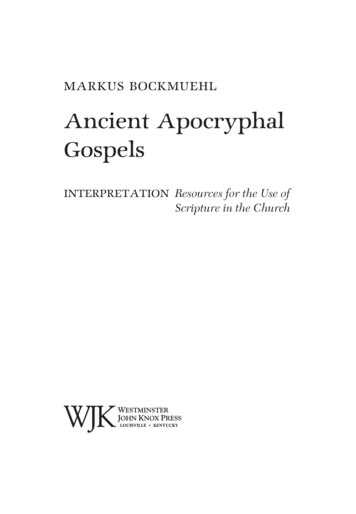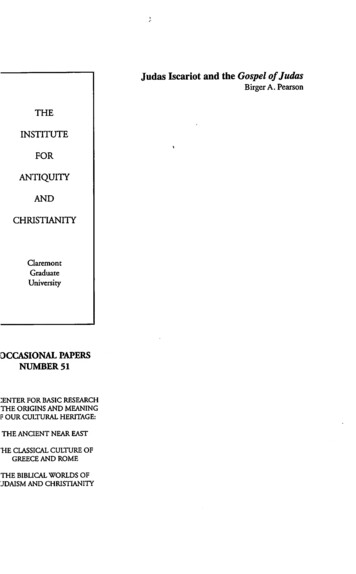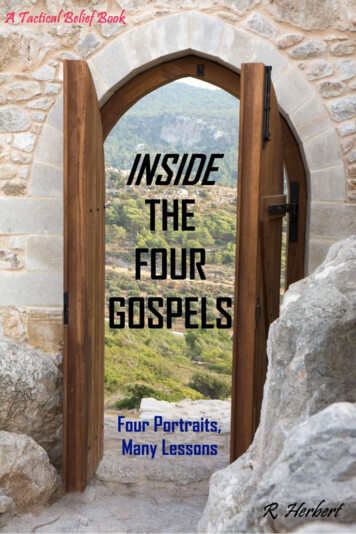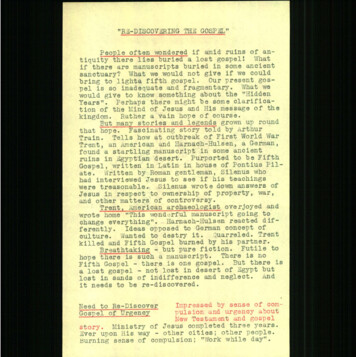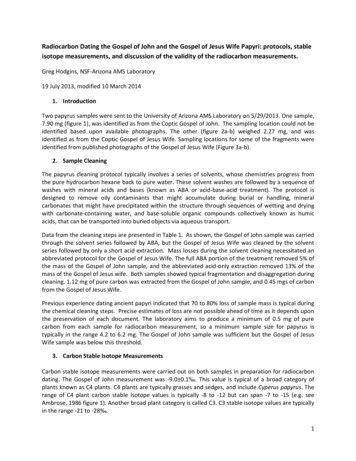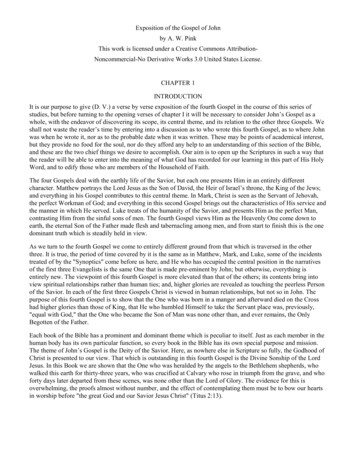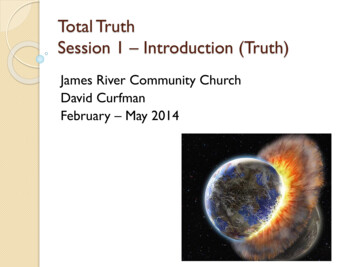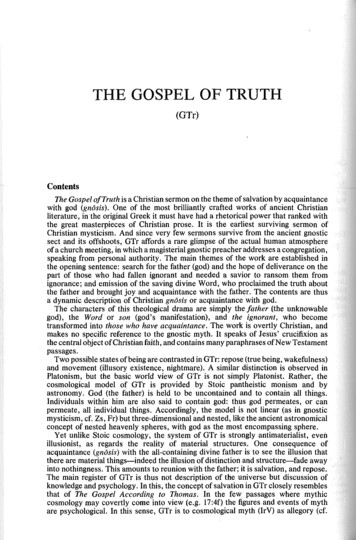
Transcription
THE GOSPEL OF TRUTH(GTr)ContentsThe Gospel o f Truth is a Christian sermon on the theme of salvation by acquaintancewith god (gnosis). One of the most brilliantly crafted works of ancient Christianliterature, in the original Greek it must have had a rhetorical power that ranked withthe great masterpieces of Christian prose. It is the earliest surviving sermon ofChristian mysticism. And since very few sermons survive from the ancient gnosticsect and its offshoots, GTr affords a rare glimpse of the actual human atmosphereof a church meeting, in which a magisterial gnostic preacher addresses a congregation,speaking from personal authority. The main themes of the work are established inthe opening sentence: search for the father (god) and the hope of deliverance on thepart of those who had fallen ignorant and needed a savior to ransom them fromignorance; and emission of the saving divine Word, who proclaimed the truth aboutthe father and brought joy and acquaintance with the father. The contents are thusa dynamic description of Christian gnosis or acquaintance with god.The characters of this theological drama are simply the fa ther (the unknowablegod), the Word or son (god’s manifestation), and the ignorant, who becometransformed into those who have acquaintance. The work is overtly Christian, andmakes no specific reference to the gnostic myth. It speaks of Jesus’ crucifixion asthe central object of Christian faith, and contains many paraphrases of New Testamentpassages.Two possible states of being are contrasted in GTr: repose (true being, wakefulness)and movement (illusory existence, nightmare). A similar distinction is observed inPlatonism, but the basic world view of GTr is not simply Platonist. Rather, thecosmological model of GTr is provided by Stoic pantheistic monism and byastronomy. God (the father) is held to be uncontained and to contain all things.Individuals within him are also said to contain god: thus god permeates, or canpermeate, all individual things. Accordingly, the model is not linear (as in gnosticmysticism, cf. Zs, Fr) but three-dimensional and nested, like the ancient astronomicalconcept of nested heavenly spheres, with god as the most encompassing sphere.Yet unlike Stoic cosmology, the system of GTr is strongly antimaterialist, evenillusionist, as regards the reality of material structures. One consequence ofacquaintance (gnosis) with the all-containing divine father is to see the illusion thatthere are material things—indeed the illusion of distinction and structure—fade awayinto nothingness. This amounts to reunion with the father; it is salvation, and repose.The main register of GTr is thus not description of the universe but discussion ofknowledge and psychology. In this, the concept of salvation in GTr closely resemblesthat of The Gospel According to Thomas. In the few passages where mythiccosmology may covertly come into view (e.g. 17:4f) the figures and events of mythare psychological. In this sense, GTr is to cosmological myth (IrV) as allegory (cf.
251T H E G O S P E L OF T RU THthe “ Historical Introduction” to Part Three) is to text. In this almost completeallegorization, the underlying dynamic of gnostic myth (fullness—lack—recaptureof the lacked) is reapplied microcosmically, at the level of the individual Christian.The theology of GTr uses the simple biblical language of “ father” and “ son” (orpossibly “ parent” and “ offspring,” though 43: I l f seems to apply a specifically maleanatomical metaphor to the parent). It has been demonstrated that in GTr Valentinusparaphrases, and so interprets, some thirty to sixty scriptural passages, almost allfrom New Testament books (Gn, Jn, 1 Jn, Rv, Mt, Rm, 1 Co, 2 Co, Ep, Col, andHeb). Of these, it has been shown that the Johannine literature (including Rv) hashad the most profound theological influence upon Valentinus’s thought; the Paulineliterature, less so; and Mt hardly at all. To a large degree the paraphrased passageshave been verbally reshaped by abridgement or substitution, to make them agreewith Valentinus’s own theological perspective (cf. the paraphrase of Gn in RR).Though carefully controlled, the rhetoric of GTr is' not linear but atmospheric,just as its cosmology is not linear but concentric: GTr aims not to argue a thesis bylogic, but to describe, evoke, and elicit a kind of relationship. Ideas and images aredeveloped slowly by repeating key points with minor changes. As in gnostic mytha great many epithets used substantively are applied to each main character.Ambiguity of the pronouns “ he” and “ it” plays a major role in this development;this is one of the striking aspects of Valentinus’s style, and can be seen also in theFragments. Valentinus’s style—quite apart from his mystic theology or theory ofsalvation—is probably unique within ancient Christian literature; it has been describedas a gnostic rhetoric.Literary backgroundThe manuscripts do not specify the title or author of GTr. The conventional titlehas been supplied by scholarship; it may be a mistake to suppose that Valentinusever gave a title to the work. In any case, the second-century father of the church,St. Irenaeus of Lyon, states that the Valentinian church read a Gospel (orProclamation) o f Truth. Since this is the opening phrase of GTr, some scholars haveconcluded that Irenaeus must be referring to the present work.The author’s name does not appear in the manuscripts, and thus the attributionof GTr to Valentinus remains hypothetical. Nevertheless, it is extremely likely forseveral reasons: the work’s stylistic resemblance to the Fragments (whose attributionis explicit) and the uniqueness of that style; the alleged genius and eloquence ofValentinus and the lack of a likely candidate for the authorship among later Valentinianwriters; and the absence of a developed system in the work, perhaps suggesting thatit belongs early in the history of the Valentinian church.The place and exact date of composition of GTr are unknown (Valentinus diedca. 175); the language of composition was Greek.The work is a sermon and has nothing to do with the Christian genre properlycalled “ gospel” (e.g. the Gospel of Mark).TextThe original Greek apparently does not survive, though a remark by St. Irenaeus(see above, “ Literary background” ) may be taken as testimony to its existence.The text is known only in Coptic translation, attested by two manuscripts, FjHC I(16-43) and NHC XII (fragments), which were copied just before a .d . 350 and arenow in the Cairo Coptic Museum. The two Coptic manuscripts contain differentversions of the text, one (NHC I) in a Subachmimic dialect of Coptic and the other(NHC XII) in the Sahidic dialect of Coptic. The two versions seem to have beentranslated from slightly different ancient editions of the Greek text. The Sahidicmanuscript (NHC XII) has been almost completely destroyed and survives in the
THE GOSPEL OF TRUTHform of a few fragments; the Subachmimic manuscript (NHC I) is virtually complete.For that reason, the present translation is from the Subachmimic MS (NHC I) alone.The translation below is based upon the critical edition of the Coptic by Malinineet al., with some alterations and with improved readings introduced from anunpublished collation of the manuscript made by S. Emmel and kindly supplied byhim: M. Malinine et al., Evangelium Veritatis, 2-48, and Evangelium Veritatis[Supplementumj, 2-8 (see “ Select Bibliography” ).SELECT BIBLIOGRAPHYArai, S. Die Christologie des Evangelium Veritatis: Eide religionsgeschichtlicheUntersuchung. Leiden: E. J. Brill, 1964.Attridge, H ., and G. MacRae. “ The Gospel of Truth.” In Nag Hammadi Codex I,edited by H. Attridge, Vol. 1, Introductions, Texts . . ., 55-117, and vol. 2,Notes, 39-135. Nag Hammadi Studies, vols. 22, 23. Leiden: E. J. Brill, 1985.Barrett, C. K. “ The Theological Vocabulary of the Fourth Gospel and of the Gospelof T ruth.” In Current Issues in New Testament Interpretation: Essays in Honoro f Otto A. Piper, edited by W. Klassen and G. F. Snyder, 210-23, 297-98. NewYork: Harper & Row, 1962.Dillon, J. The Middle Platonists. London: Gerald Duckworth, 1977.Fineman, J. “ Gnosis and the Piety of Metaphor: The Gospel o f Truth.” In TheRediscovery o f Gnosticism, edited by B. Layton. Vol. 1, The School o fValentinus, 289-312 (and discussion, 312-18). Studies in the History of Religion,no. 41, vol. 1. Leiden: E. J. Brill, 1980.Grooel, K. The Gospel o f Truth: A Valentinian Meditation on the Gospel. Nashvilleand New York: Abingdon Press, 1960.Jonas, H. The Gnostic Religion. 2d ed. Boston: Beacon Press, 1963.Malinine, M., et al., eds. Evangelium Veritatis: Codex Jung f. VU Iv-XVlv, f. X lX rXXIIr. Zürich: Rascher, 1956.---------------. Evangelium Veritatis: Codex Jung f . X V IIr-f. XVIIIv. Zürich and Stutt gart: Rascher, 1961.Marrou, H.-I. “ L ’Évangile de vérité et la diffusion du comput digital dans l’antiquité."Vigiliae Christianae 12 (1958): 98-103.Ménard, J.-E. L ’Évangile de vérité. Nag Hammadi Studies, vol. 2. Leiden: E. J.Brill, 1972.Schoedel, W. R. “ Gnostic Monism and The Gospel o f Truth.” In The Rediscoveryo f Gnosticism, edited by B. Layton. Vol. 1, The School o f Valentinus, 379-90.Studies in the History of Religion, no. 41, vol. 1. Leiden: E. J. Brill, 1980.Standaert, B. “ ‘Evangelium Veritatis’ et ‘Veritatis Evangelium.’ La Question dutitre et les témoins patristiques.” Vigiliae Christianae 30 (1976): 138-50.---------------. “ L ’Évangile de vérité: critique et lecture.” New Testament Studies 22(1976): 243-75.van Unnik, W. C. “ ‘The Gospel of T ruth’ and the New Testam ent.” In The JungCodex, translated and edited by F. L. Cross, 79-129. London: A. R. Mowbray,1955.Williams, J. A. “ The Interpretation of Texts and Traditions in the Gospel of T ruth.”Ph.D. diss., Yale University, 1983. (Biblical paraphrases in GTr and theirtheological implications.)
THE GOSPEL OF TRUTHaPrologue16 The proclamation11of the truth is a joy for those who have receivedgrace from the father of truth, ‘that they might learn to know him'through the power of the Wordd that emanated from the fullness' that is36 in the father’s thought' and intellect—the Word, »who is spoken of as“ savior” : for, that is the term for the work that heg was to accomplishi to ransom those who had fallen ignorant 17 of the father; »whilethe term “ proclamation” refers to the manifestation of hope, a discoveryfor those who are searching for him.31M k 1:1 ?33IrV (c)IrV (c)VFrAIrV (e)I. THE ORIGIN OF IGNORANCEThe creation4Inasmuch as the entirety“ had searched for the one from whom theyhad emanated, and the entirety was inside of him—the inconceivable9 uncontained, who is superior to all thoughtb—»ignorance of the fathern caused agitation and fear. »And the agitation grew dense like fog, so14 that no one could see. »Thus erro r' found strength and labored at her1 in emptiness. »Without having learned to know the truth, she17 m atter“took up residence in a modeled form ,' preparing by means of the pow er/in beauty, a substitute for truth.The unreality of creation1,2328Now, to the inconceivable uncontained this was not humiliating; »forthe agitation and forgetfulness and the modeled form of deception wereas nothing, whereas established truth is unchangeable, imperturbable,and cannot be beautified. »For this reason despise error, since she hasno root.8Forgetfulness3033She dwelt in a fog as regards the father, preparing, while she dweltthere, products and forgetfulness and fears, »so that by them she might16 a. Or “ The Proclamation o f Truth.” Notitle is given in the MSS. The present titlehas been supplied by modem scholars, fol lowing a statement by St. Irenaeus (cf. theintroduction to GTr).b. "proclam ation” (Gk. euaggelion): theGreek word can be translated also “ gospel."The title plays on this double meaning.c. “ father . . . him” (or “ p a re n t. . . it” ):traditional anthropomorphic Christian lan guage for reference to the highest deity isused in this work.d. “ Word” (Gk. Logos): or “ verbalexpression.”e. “ fullness” : Valentinian jargon for thespiritual universe.f. Or “ thinking” ; cf. BJn 4:26f.g. “ he” (or “ it” ): traditional Christiananthropomorphic language for reference tothe mediating principle (Word, son) is usedin this work.17 a. “ entirety” : gnostic jargon for the sumtotal of spiritual reality deriving from theBarbelo aeon or second principle; here itrefers especially to spiritual reality as alien ated from its source.b. Cf. BJn 3:22-26.c. “ error” : a feminine personification cor responding to both wisdom and Ialdabaothin gnostic myth. The present section (17:4—17f) is an allegorical equivalent of the pro duction of Ialdabaoth and the creation of theuniverse and humankind in gnostic myth.d. “ her m atter” : the material universe,which belonged to error.e. Jewish and Christian jargon for thehuman body, based on the fact that thecreator modeled Adam out of earth. Theword (Gk. plasma) also means “ fiction, fab rication.”f. “ the power” : cf. BJn 10:20f.g. “ root": source.IrV (i)IrV (b)29:1, V F rCR m 1:21 ?v.14V FrCIrV (g)
254THE GOSPEL OF TRUTH17:3636 beguile those of the middleh and take them captive. «The forgetfulnessthat belongs to error is not apparent; it is not (?) 18 [. . .] with the1 father. »It was not in the father’s company that forgetfulness arose, and4 surely then not because of him! Rather, what comes into being withinhim is acquaintance, which appeared so that forgetfulness might perish7 and the father might come to be known. »Inasmuch as forgetfulnessarose because the father was unknown, from the moment the fathercomes to be known, there will no longer be forgetfulness.II.DISCOVERY OF THE FATHERThe crucified Jesus is god within1115It is to the perfect“ that this, the proclamation of the one they search c o i 1 : 2 5for, has made itself known, through the mercies of the father. »By thisthe hidden mystery Jesus Christ shed light upon those who were, becauseof forgetfulness, in darkness. »He enlightened them and gave them a j n 1 4 :6way, and the way is the truth, about which he instructed them. »Forthis reason error became angry at him and persecuted him. »She wasconstrained by him, and became inactive. »He was nailed to a treeb and G n 2 : 1 7became fruit of the father’s acquaintance. »Yet it did not cause ruin Gn3:7because it was eaten. »Rather, to those who ate of it, it gave thepossibility that whoever he discovered within himself might be joyful inthe discovery of him. »And as for him, they discovered him withinthem—the inconceivable uncontained, the father, who is perfect, who J 9 .-7 , c o icreated the entirety.v iy his212324262731Existence within the fatherBecause the entirety was within him and the entirety was in need ofhimc—since he had retained within him self its completion, which he hadnot given unto the entirety—the father was not grudging; for what envy40 is there between him and his own members? »For if 19 this realm had[. . .] them, they would not be able to [. . .] the father, retaining theircompletion within himself, in that it [was] given them in the form of7 return to him and acquaintance and completion. »It is he who created18.-319 the entirety, and the entirety is in him. »And the entirety was in need Co11:1610 of him: »just as someone who is unknown to certain people might wish14 to become known, and so become loved, by them. »For what did theentirety need if not acquaintance with the father?34The savior as teacher1 7 ,1 921He became a guide,“ at peace and occupied with classrooms. »Hecame forward and uttered the word as a teacher. »The self-appointedwise people came up to him, testing him, but he refuted them, for theywere empty; and they despised him, for they were not truly intelligent.h.I.e. ordinary Christians (?). In laterValentinian theology, “ the middle” is therealm of the “ju s t,” who can waver betweengood and evil, as distinct from the realm ofthe spirituals (Valentinians) and the father;cf. IrPt 1.7.1 Valentinus's own teaching onthis subject is unknown.18. a. “ the perfect” : the elect, who havebeen chosen for salvation,b. “ a tree": Christian jargon for the cross,but here also contrasted with the tree ofacquaintance with good and evil, Gn 2:17,which in the non-gnostic reading “causedruin” to Eve and Adam.c.“ in need of him ": had a lack of him,cf. note 24a.19. a. Or “ pedagogue,” a trained slave whoaccompanied schoolchildren to the class room and supervised their conduct.1 .16
2552730THE G OSPEL OF TRUTHAfter them all, came also the little ones, to whom belongs acquaintancewith the father. «Once they were confirmed and had learned about theoutward manifestations of the father they gained acquaintance, theywere known; they were glorified, they gave glory.21:284 3 :2 2 III. PREDESTINATION TO SALVATIONThe book of the livingIn their hearts appeared the living book of the living, which is written 3 2 : 3 1 in the father’s thought and intellect. 20 «And since the foundation of the . g3 entirety it had been among his incomprehensibles: »and no one had beenR v 5 :3able to take it up, inasmuch as it was ordained that whoever should take6 it up would be put to death. "Nothing would have been able to appearamong those who believed in salvation, had not that book come forward.341The crucifixion and publication of the book10Therefore the merciful and faithful Jesus became patient and accepted Heb 2 : 1 7the sufferings even unto taking up that book: inasmuch as he knew that rv 5:714 his d eath w ould m ean life fo r m an y . "B efo re a will“ is o p e n e d , th e e x te n t “ ‘t?19 U7 ?19of the late property owner’s fortune remains a secret; just so, the entiretywas concealed. "Since the father of the entirety is invisible—and theentirety derives from him, from whom every way emanated—Jesusappeared, wrapped himself in that document, was nailed to a piece of c0i2:i427 wood, and published the father’ s edict upon the cross. *0 , such a great28lesson! "Drawing himself down unto death, clothed in eternal life, having i c o 1 5 :5 3put off the corrupt rags,b he put on incorruptibility, a thing that no one {¡-v2* /can tak e from him . "H aving e n te re d u p o n th e em p ty w a y s o f fe a r, h e Jn 10:17escap ed the clu tc h e s o f th o se w ho had b e e n strip p e d nak ed b y forget38 fu ln ess, "for he w as a c q u a in ta n c e an d c o m p letio n , an d re a d o u t [their]341 ,3contents 21 [ . . . ] . "When [. . .] instruct whoever might learn. "Andthose who would learn, [namely] the living enrolled in the book of theliving, learn about themselves, recovering themselves from the father,and returning to him.Predestination of the elect8Inasmuch as the completion of the entirety is in the father, the entiretymust go to him. "Then upon gaining acquaintance, all individually receive14 what belongs to them, and draw it to themselves.“ "For whoever doesnot possess acquaintance is in need, and what that person needs is great, vFrDinasmuch as the thing that such a person needs is what would completeis the person.b "Inasmuch as the completion of the entirety resides in the2 3 father, and the entirety must go to him and all receive their own, "he J n 1 2 :3 2inscribed these things in advance, having prepared them for assignment VFrFto those who (eventually) emanated from him.11Calling of the elect2528Those whose names he foreknew were called at the end, as persons R m 8 :2 9having acquaintance. *It is the latter whose names the father called. VFrH20 a. Or "testam ent."b. "corrupt rags” : it was a Platonist clichéthat the human body is the garment of thesoul.21 a. "and draw it to themselves” , or “ andhe draws them to himself.”b. “ what would complete the person” : or“ what would complete him.”
THE G O S P E L OF T R U T H2 1:3 030323437IFor one whose name has not been spoken does not possess acquaintance.How else would a person hear, if that person’s name had not been readout? *For whoever lacks acquaintance until the end, is a modeled formof forgetfulness, and will perish along with it. "Otherwise, why do thesecontemptible persons have no 22 name? "Why do they not possess thefaculty of speech?Jn 10:3 ?Response to the callSo that whoever has acquaintance is from above: «and if called, hears,replies, and turns to the one who is calling; and goes to him. »And he9 knows how that one is called.8 "Having acquaintance, that person doesII the will of the one who has called; "wishes to please him; and gains12,13 repose. "One’s name becomes one’s own. "Those who gain acquaintancein this way know whence they have come and whither they will go;16 they know in the manner of a man who, after having been intoxicated,is has recovered from his intoxication: "having returned into himself, hehas caused his own to stand at rest.b20He has brought many back from error, going before them unto theirways from which they had swerved after accepting error because of thedepth of him who surrounds every way, while nothing surrounds him.2 7 It was quite amazing that they were in the father without being acquaintedwith him and that they alone were able to emanate, inasmuch as theywere not able to perceive and recognize the one in whom they were.2 ,4Jn 3:31 ?7Contents of the bookFor had not his will emanated from him {. . .)c "For he revealed it to38 bestow an acquaintance in harmony with all its emanations, "that is tosay, acquaintance with the living book, an acquaintance which at theend appeared to the 23 aeons8 in the form of [passages of text from] it.2 ,3When it is manifest, they speak: "they are not places for use of thevoice, nor are they mute texts for someone to read out and so think of8 emptiness; "rather, they are texts of truth, which speak and know only11 themselves. "And each text is a perfect truth—like a book that is perfectand consists of texts written in unity, written by the father for the aeons:so that through its passages of text the aeons might become acquaintedwith the father.3 3 .3 5IV.SALVATIONThe advent of the Word1820212324Itsb wisdom meditates upon the Word.Its teaching speaks himc forth.Its acquaintance has revealed (him).dIts forbearance is a crown upon him.Its joy is in harmony with him.22 a. Or "h e knows how he is called.”b. To "stand at rest” is philosophicaljargon for the state of permanence, non change, and real being, as opposed to whatexists in instability, change, and becoming.c. One or more words are inadvertentlyomitted here.23 a. Or “ eternal realm s." In gnostic myth,the aeons are emanations of the first principleand compose the structure of the spiritualuniverse, which contains only aeons.b. “ Its": here and throughout the passage(23:18—31f) the Coptic word also can betranslated " H is."c. “ him” : here and throughout the pas sage (23:18—31f) the Coptic word can betranslated also “ it.”d. Through an inadvertence, the MS omitsthis word.Jn 3:8Jn 10:4 ?
2572627293031THE G OSPEL OF TRUTH26:8Its glory has exalted him.Its manner has manifested him.Its repose has taken him to itself.Its love has clothed him with a body.Its faith has guarded him.Ingathering of the electIn this manner the Word of the father goes forth in the entirety, beingthe fruition 24 [of] his heart and an outward manifestation of his will,personally supporting the entirety and choosing it, and also taking the6 outward manifestation of the entirety and purifying it, «bringing it backinto the father, into the mother, Jesus of the infinity of sweetness.42 :i69And the father uncovers his bosom—now, his bosom is the holy spirit, jn msM and reveals his secret—his secret is his son, «so that out of the father’sP 3 :9 ?bowels they (the entirety) might learn to know him, and the aeons mightno longer be weary from searching for the father, might repose in him,20 and might know that he is repose, «for he has supplied the lack“ and2 2 nullified the realm of appearance. «The realm of appearance, whichic o 7 :3 ib ?belongs to it (the lack), is the world, in which it served.VFrF33eDisappearance of the material worldFor where there is envy and strife there is a lack, but where unity is,there is completion. «Inasmuch as the lack came into being because thefather was not known, from the moment that the father is known the3 2 lack will not exist. «As with one person’s ignorance (of another)—whenone becomes acquainted, ignorance of the other passes away of its own3 7 accord; «and as with darkness, which passes away when light appears:i 25 so also lack passes away in completion, and so from that momenton, the realm of appearance is no longer manifest but rather will passaway in the harmony of unity.7 .8For now their affairs are dispersed. «But when unity makes the wayscomplete, it is in unity that all will gather themselves, and it is byacquaintance that all will purify themselves out of multiplicity into unity,consuming matter within themselves as fire, and darkness by light, and1 9 death by life. «So since these things have happened to each of us, it is22 fitting for us to meditate upon the entirety, «so that this house might beholy and quietly intent on unity.25282Co 5:4 ?A parable of jarsIt is like some people who moved to a new house. «They had somejars that in places were no good, and these got broken; but the ownerof the house suffered no loss, rather the owner was glad because insteadof the bad jars it was (now) the full ones that they would be going to3 5 use up. «For this is the judgment that has come 26from above, having jn 3;i9judged everyone—a drawn two-edged sword cutting this way and that, Heb4:i2?since the Word that is in the heart of those that speak it, has come jn i:i47.8 forward. «It is not just a sound, but it became a body. «A great disturbancehas come to pass among the jars; for some have leaked dry, some arehalf full, some are well filled, some have been spilled, some have beenwashed, and still others broken.2 5 ,2 724 a. “ lack": in gnostic myth, the missingpower stolen by Ialdabaoth from its motherwisdom. In GTr the lack is mutual, betweenthe divine fullness and the individual aeon.
26:15THE G O SPEL OF TRUTHLament and downfall of error1518,2026273235,36279All the ways moved and were disturbed, for they had neither basisnor stability; «and error became excited, not knowing what to do; [she]was troubled, mourned, and cried out that she understood nothing,inasmuch as acquaintance, which meant the destruction of her and allher emanations, had drawn near to her. «Error is empty, with nothinginside her. «Truth came forward: all its emanations recognized it, andthey saluted the father in truth and power (so) perfect that it set themin harmony with the father. «For everyone loves truth since truth is thefather’s mouth; «his tongue is the holy spirit. «Whoever attaches 27 to IrV 0)the truth attaches to the father’s mouth; «it is from his tongue that this V FrBperson will receive the holy spirit, that is to say, the .revealing of thefather and the uncovering of him to his aeons. «He has revealed his Col 1:26 1secret; he has unloosed himself.“ «For who but the father alone contains(anything)?Potential being and real beingAll the waysb are his emanations. «They know that they have emanatedfrom him like children who were within a mature man but knew theyis had not yet received form nor been given name. «It is when they receivethe impulse toward acquaintance with the father that he gives birth to22 each. «Otherwise, although they are within him they do not recognize23 him. «The father himself is perfect and acquainted with every way that26 is in him. «If he wills, what he wills appears, as he gives it form and2 9 name. «And he gives it name, and causes it to make them come intoexistence.31 Those who have not yet come to be are not acquainted with the one34 who put them in order. «Now, I am not saying that those who have not36 yet come to be are nothing: «rather, that they exist 28 within him whomight will that they come to be, if he wills at some future time, as it4 were. «Before all things have appeared he is personally acquainted with7 what he is going to produce. «But the fruit that has not yet appeared10 recognizes nothing, nor is it at all active. «Just so, also all the ways that13 reside in the father derive from the existent, «that being which has16 caused itself to stand at rest from out of the nonexistent. «For what has18 no root also has no fruit: «truly, although it may think to itself, “ I have22 come into being,” next it will wither of its own accord. «Accordingly,io . i iMt 5:48U n 3:20 :24 w hat w as w holly n o n e x iste n t will n o t co m e in to being. «W hat th e n d o eshe w an t it to th in k ? «This: “ I h av e co m e in to being (only) in th e m a n n e r2628of shadows and apparitions of the night.” «0 the light’s shining on thefear of that person, upon knowing that it is nothing!The nightmare state and awakeningThus they were unacquainted with the father, since it was he whomi 29 they did not see. «Inasmuch as he was the object of fear anddisturbance and instability and indecisiveness and division, there wasmuch futility at work among them on his account, and (much) empty8 ignorance—«as when one falls sound asleep and finds oneself in the11 midst of nightmares: «running toward somewhere—powerless to getaway while being pursued—in hand-to-hand combat—being beaten—3227 a. Or “ he has explained it” (with thistranslation cf. possibly Jn 1:18).b. “ ways” : this obscure term apparentlyrefers to the aeons or potential aeons.17:9
259T H E G O S P E L OF T R U T Hfalling from a height—being blown upward by the air, but without anywings; »sometimes, too, it seems that one is being murdered, thoughnobody is giving chase—or killing one’s neighbors, with whose blood25 one is smeared: »until, having gone through all these dreams, one28 awakens. »Those in the midst of all these troubles see nothing, for such32 things are (in fact) nothing. »Such are those who have cast off lack ofacquaintance from themselves like sleep, considering it to be nothing.3 7
Christian mysticism. And since very few sermons survive from the ancient gnostic sect and its offshoots, GTr affords a rare glimpse of the actual human atmosphere of a church meeting, in which a magisterial gnostic preacher addresses a congregation, . from New Testament books (Gn, Jn, 1 Jn, Rv, Mt, Rm, 1 Co, 2 Co, Ep, Col, and Heb). Of these .


